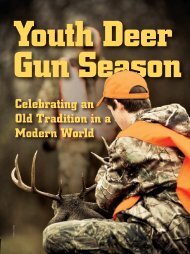A Conservation Timeline - Oklahoma Department of Wildlife ...
A Conservation Timeline - Oklahoma Department of Wildlife ...
A Conservation Timeline - Oklahoma Department of Wildlife ...
You also want an ePaper? Increase the reach of your titles
YUMPU automatically turns print PDFs into web optimized ePapers that Google loves.
Origin <strong>of</strong> the Public Trust Doctrine<br />
In 1842, the U.S. Supreme Court denied a landowner’s<br />
effort to exclude people from taking oysters<br />
from New Jersey mudflats he claimed as his own.<br />
The decision referred to England’s Magna Carta <strong>of</strong><br />
1215, noting that the document guarded “the public<br />
and common right <strong>of</strong> fishing in navigable waters.”<br />
This decision codified the concept <strong>of</strong> the Public Trust<br />
Doctrine, which holds that, in the U.S., wildlife and<br />
fish belong to all the people, and stewardship <strong>of</strong><br />
those fauna is entrusted to the individual states.<br />
1844: The New York Sportsmen’s Club forms and in<br />
1848 drafts laws to regulate trout fishing and<br />
the hunting <strong>of</strong> woodcock, quail, and deer.<br />
1854: Henry David Thoreau publishes Walden, his<br />
treatise on the solace <strong>of</strong> nature.<br />
Collapse <strong>of</strong> the Bison<br />
Railroad expansion in the 1860s and ‘70s made<br />
shipping bison hides, meat, and tongues economical—and<br />
marked a period <strong>of</strong> wildlife slaughter<br />
perhaps unparalleled in U.S. history. The annual<br />
bison kill in 1865 was one million animals; by 1871<br />
that toll had soared to five million.<br />
1872: President Ulysses S. Grant establishes Yellowstone<br />
National Park, with 3,348 square miles.<br />
1886: A census reveals that only 540 bison remain<br />
in the entire U.S., mostly in the Yellowstone<br />
area <strong>of</strong> Montana.<br />
Clubs to the Fore<br />
Dozens <strong>of</strong> hunting, conservation, and scientific<br />
organizations formed in the 1880s, including<br />
the League <strong>of</strong> American Sportsmen, the American<br />
Ornithologist’s Union, the Camp Fire Club,<br />
the New York Zoological Society, the Audubon<br />
Society, and the American Bison Society. These<br />
groups lobbied for stricter laws to<br />
stop market hunting for meat and<br />
hides and for feathers for the millinery<br />
trade. They also fought for<br />
bans on wasteful sport hunting.<br />
1881: Approximately 60 ringnecked<br />
pheasants from<br />
Shanghai, China, arrive in<br />
Washington state. Most die<br />
during a subsequent shipment<br />
to Oregon, but the survivors<br />
are released and followed by<br />
© The <strong>Wildlife</strong> Society<br />
Credit: Keith Schengili-Roberts/Wikimedia<br />
flocks <strong>of</strong> passenger pigeons<br />
darkened the sky in the early<br />
1800s. Just a century later<br />
the species was extinct, a<br />
victim <strong>of</strong> unregulated hunting.<br />
a second shipment in 1882—an introduction<br />
that leads to the establishment <strong>of</strong> pheasants<br />
as one <strong>of</strong> the most popular game species in<br />
North America.<br />
1887: Theodore Roosevelt, George Bird Grinnell,<br />
and other influential hunter-conservationists<br />
gather in New York to form the Boone and<br />
Crockett Club, with a mission to preserve the<br />
big game <strong>of</strong> North America.<br />
1892: John Muir and others form the Sierra Club,<br />
dedicated to the preservation <strong>of</strong> the Pacific<br />
Coast and Sierra Nevada wilderness.<br />
Age <strong>of</strong> Legislation<br />
Legislators in the last decade <strong>of</strong> the 19th century<br />
acted on a growing awareness <strong>of</strong> the need for natural<br />
resources conservation, taking action to protect<br />
disappearing wildlands, passing laws establishing<br />
national parks and forests, and protecting wildlife.<br />
1891: Congress passes the Forest Reserve Act and<br />
creates Shoshone National Forest, the nation’s<br />
first federally managed forest reserve.<br />
1898: Gifford Pinchot becomes the first chief <strong>of</strong> the<br />
Division <strong>of</strong> Forestry, renamed the U.S. Forest<br />
Service in 1905.<br />
1900: Congress passes the Lacey Game and Wild<br />
Birds Preservation and Disposition Act, making<br />
it a federal <strong>of</strong>fense to transport illegally<br />
taken wild game across state borders.<br />
The <strong>Conservation</strong> President<br />
An avid hunter and advocate for the conservation<br />
<strong>of</strong> game and wild lands, Theodore Roosevelt<br />
served as President from 1901 to 1909—and<br />
launched a conservation agenda unmatched by<br />
other leaders. In all, Roosevelt set aside 230<br />
million acres during his presidency—more than<br />
80,000 acres for each day he was in <strong>of</strong>fice, includ-<br />
Credit: Jim Peaco/NPS<br />
Yellowstone National Park—a<br />
symbol <strong>of</strong> the majesty <strong>of</strong> the<br />
natural world—was protected<br />
by President Grant in 1872.<br />
Credit: library <strong>of</strong> Congress<br />
theodore Roosevelt and John<br />
Muir admire Yosemite valley<br />
from Glacier Point in 1903—<br />
land their efforts helped protect<br />
for generations.<br />
www.wildlife.org<br />
29







